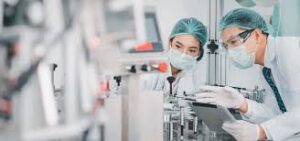
- Blogs
The Role of Medical Equipment in Occupational Health
- September 19, 2024
- By admin
Occupational health focuses on the well-being, safety, and health of employees in the workplace. Ensuring a safe and healthy working environment requires continuous monitoring, prevention, and management of health risks, which is where medical equipment plays a critical role. From diagnostic tools to monitoring devices, medical equipment is essential in managing occupational health effectively. Here are the key roles that medical equipment plays in this vital area of healthcare:
1. Health Screening and Diagnostics
Medical equipment such as blood pressure monitors, spirometers, and hearing testers are commonly used in occupational health assessments. Regular health screenings help identify potential health issues that could impact an employee’s ability to perform their job safely. Early detection of conditions like hypertension, respiratory problems, or hearing loss ensures timely intervention, preventing more severe health problems down the line.
2. Monitoring Work-Related Hazards
Occupational health professionals rely on specialized medical equipment to monitor and control work-related hazards. For example, noise level meters and air quality analyzers are used to measure exposure to harmful environmental conditions like excessive noise or toxic fumes. Regular monitoring with the right equipment ensures that workplaces remain compliant with health and safety regulations and helps reduce the risk of long-term health issues for workers.
3. Managing Workplace Injuries
In industries such as construction, manufacturing, and healthcare, workplace injuries are a significant concern. Medical equipment, including first aid kits, automated external defibrillators (AEDs), and emergency oxygen equipment, are essential for managing injuries on-site. Having the right medical tools readily available can mean the difference between life and death in critical situations, enabling prompt and effective responses to emergencies.
4. Ergonomic Assessments
Ergonomics plays a crucial role in preventing work-related musculoskeletal disorders. Equipment such as posture analyzers, pressure mapping systems, and wearable sensors help assess the ergonomics of a workstation and identify potential risks. By using these tools, occupational health professionals can make recommendations for improving workplace ergonomics, which reduces strain and injury risks for employees.
5. Rehabilitation and Recovery
For employees who suffer from injuries or chronic conditions, rehabilitation equipment is essential for facilitating recovery and returning to work. Devices like exercise bikes, physiotherapy tools, and mobility aids help in the rehabilitation process by strengthening muscles, improving mobility, and reducing recovery times. Having access to quality rehabilitation equipment supports both employees and employers by promoting faster recoveries and reducing downtime.
6. Health Surveillance Programs
In industries where workers are exposed to hazardous substances, health surveillance programs are critical. Medical equipment like lung function testers, X-ray machines, and blood analysis tools are used to monitor the health of workers who are exposed to risks like chemicals, dust, or radiation. Regular health checks, using advanced diagnostic tools, help ensure that workers remain healthy and that any health issues are detected early.
7. Promoting Mental Health
Mental health is a growing concern in occupational health, with stress, anxiety, and burnout becoming increasingly common in many workplaces. Medical equipment such as stress monitors and biofeedback devices can be used to assess an employee’s mental well-being. These tools can identify signs of stress and anxiety early, allowing for interventions that promote mental health and overall well-being.
8. Compliance with Occupational Health Standards
Medical equipment is also essential for ensuring compliance with occupational health standards and regulations. In countries like the UAE, where workplace safety is strictly regulated, medical equipment in Dubai is widely used to meet occupational health and safety standards. Whether it’s through regular health screenings or environmental monitoring, this equipment ensures that businesses are following the law and protecting their workers.
Conclusion
Medical equipment plays an indispensable role in occupational health, from preventing workplace injuries to monitoring employee well-being. By utilizing the right tools, occupational health professionals can ensure that workers stay healthy, safe, and productive. Whether it’s through routine health checks, managing work-related hazards, or promoting recovery, medical equipment is a key component in maintaining a safe and healthy workplace. Moreover, the integration of advanced medical equipment in Dubai has helped businesses create healthier and safer environments, contributing to overall employee satisfaction and productivity.
Related Posts

Importance of Routine Medical Equipment Maintenance in Ensuring Patient Safety and Compliance.
Read More »
Medical Laboratory Excellence: A Complete Guide to Equipment Selection and Cost-Effective Planning
Read More »Explore Our Range
Visit our website to discover our full range of medical equipment in Dubai and see how Regal Medical Equipments Trading LLC can support your healthcare practice. Whether you’re upgrading your current equipment or need specialized tools, we offer exceptional products and unparalleled customer service to meet your specific needs.



